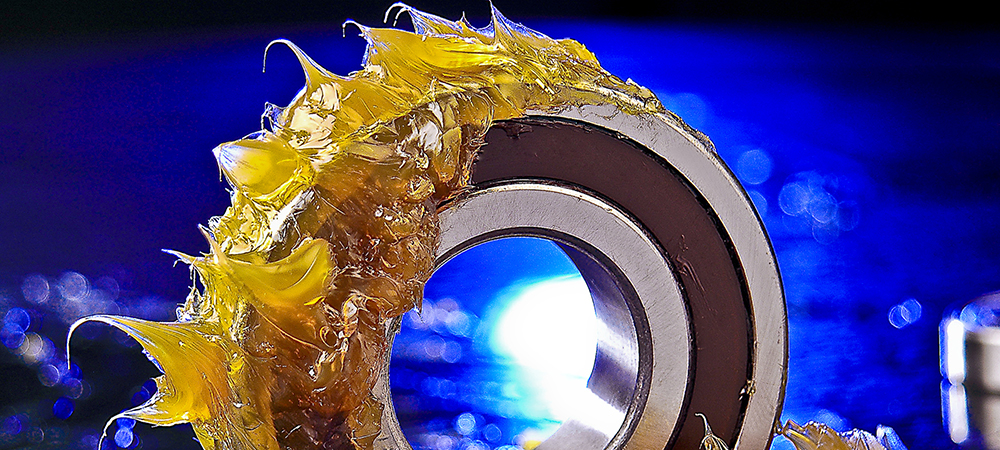Grease Bleed Separation – What You Need to Know

Grease Bleed Separation
Understanding Grease and Oil Bleed Separation
Oil and grease often separate and bleed over time, leaving easily recognizable oily sections within greased equipment, as well as the presence of small pools of standing oil in the middle of and around the edge and lid of a grease container. Understanding how to recognize these signs of what is referred to as “static oil bleed” and what you can do about them is an important part of protecting your equipment from unnecessary wear and costly damage. In this article we explore what is happening with grease bleed separation, whether or not it is normal, contributing factors and what you can do about them.
How is Grease Different From Oil
Grease and oil are both lubricant products used in a wide range of industrial equipment and machinery. The primary difference between grease and oil is that grease has both an oil and an added thickener, making it semi-solid to solid in consistency. This allows grease the ability to stay isolated in one place within a machine component, whereas the viscosity of oil alone is usually runny and slippery in consistency. ExxonMobile’s definition of a grease states that, “Grease is oil that has been mixed into a soap in order to hold the lubricating oil in place.” Grease is also defined by the American Society for Testing and Materials (ASTM International) as “A semifluid to solid…dispersion of a thickener in a liquid lubricant… (where) other ingredients are commonly included to impart special properties.” Grease is in some ways like a sponge, suspending oil and then releasing it as needed for specific applications. The absorbed oil is released by the chemical properties of the types of thickeners used, as well as by the speed and temperature at which they are being utilized.
Is Grease Bleed Separation Normal
Small occurrences of “static” grease bleed separation are considered to be normal, under normal operating conditions. Separated oil in the form of small pools or on the surface of grease pails or containers can be reincorporated back into the grease product by stirring. These small pools of oil within the grease or around equipment components are naturally occurring, yet can be increased or decreased by extreme fluctuations in temperature. There are no blanket industry standards for acceptable amounts of grease or oil bleed, and as long as the oil does not begin leaking excessively, referred to as a “dynamic bleed,” a grease should continue to perform properly. An indication of relatively normal bleed conditions lies in your ability to easily stir it back into the top 1-2 inches of the product prior to use. For horizontally stored grease tubes, bleed and separation may also occur, making the exterior of the tubes appear dirty, but the interior product should be perfectly safe for use. You will know that your grease has separated to an abnormal degree, moving from “static” to “dynamic grease bleeding” if the product itself has hardened and you are unable to reincorporate the separated oil, or if the top of your container is completely covered with oil that has bled out. Small pools of oil are acceptable. Medium to large sized standing pools of oil are not. If this happens, contact an SCL representative or product manufacturer prior to use to avoid equipment damage.
What You Can Do to Prevent Grease Bleed Separation
In general, you will see higher levels of oil and grease separation with lower viscosity base oils. Although consistently higher temperatures will not adversely affect the chemical composition of your grease, temperature cycling can. Temperature cycling happens when you move through various extreme temperatures over a period of time, such as daily. These high rates of change, swinging from high temperatures to extremely low temperatures place stress upon the elasticity of the grease product can cause thermal fatigue over time. To ensure the quality and longevity of your grease products, make sure that they are stored in a climate controlled environment where the temperature remains relatively stable, minimizing extreme fluctuations. You can also remove the pressure on the pumping device when the grease gun or container is not in use. This pressure places an added strain upon the chemical composition of the grease and can unnecessarily draw the oil from the grease. Always reference manufacturer recommendations for proper storage for both unopened and opened grease products.
Myths and Truths Regarding Grease Bleed Separation
According to a spec sheet on ExxonMobile’s aviation grease, some common myths surrounding grease bleed and separation are that:
- If grease bleeds, it is a poor quality product
- The less a grease bleeds, the better it will perform
- Greases should never bleed, especially in their containers
- The higher the oil viscosity of a grease, the better
Common truths surrounding grease and oil bleed separation:
- Greases must bleed oil to lubricate because the thickener is not itself a lubricant
- It is critical that rate and volume of oil bleed is matched to the specific application
- High speed applications generally require higher oil release rates and vice versa for slower speed applications
- Higher oil release is also generally required for high load applications, even if they are performed at slower speeds
- Lower viscosity oils used in a grease will result in higher rates of separation
The Bottom Line
Grease is made up of a matrix of thickening agents that suspend lubricating oil that is released as needed for certain applications and under specific conditions. Grease bleed separation is a natural occurrence that does not mean that your grease has gone bad or is unusable. A normal amount of grease bleed separation is expected, with small pools of oil collecting within the surface layer of the grease, and along the rim and lid of a container. The thickening agents within grease offer no lubrication but simply hold the oil until required for mechanical use. Under the stress of a mechanical application, oil is released, and when the stress is removed, the oil is then reabsorbed. The key take aways from this article are to:
- Store your grease in a climate controlled environment, avoiding dramatic temperature cycling
- Follow the specific manufacturer storage recommendations for both vertical and horizontal grease products
- Keep a close eye on your grease to make sure oil bleed separation stays in a “static” form and does not increase to a more “dynamic” state
Contact an SCL Consultant Today
In a wide range of industrial sectors, SCL is committed to being the number one logistics and solutions provider for the products that protect and optimize the machines that keep our country moving. We pride ourselves on remaining at the forefront of industry trends and technological innovations, and as the market continues to evolve, we are committed to providing extensive product and industry knowledge and total performance satisfaction for our customers. For information on how we can assist your fleet in choosing the optimal products at a competitive price, contact an SCL consultant today.
